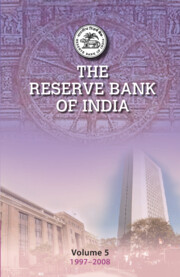Book contents
- Frontmatter
- Contents
- Tables
- Boxes
- Foreword
- Preface
- Acknowledgements
- List of Abbreviations
- 1 Introduction: Managing Liberalisation
- 2 The Macroeconomic Context
- 3 Monetary Management
- 4 Foreign Exchange Market and Management of the Capital Account
- 5 Foreign Exchange Reserves Management
- 6 Financial Markets
- 7 Public Debt Management
- 8 The Payment and Settlement Systems
- 9 Currency Management
- 10 Regulation of the Financial System – Part I: Commercial Banks
- 10 Regulation of the Financial System Part II: Other Financial Institutions
- 11 Supervision of the Financial System
- 12 Rural Credit
- 13 Financial Inclusion
- 14 Communication Policy
- 15 Organisational Change
- Appendices
- Photographs
- Select Bibliography
- Index
10 - Regulation of the Financial System – Part I: Commercial Banks
Published online by Cambridge University Press: 10 January 2023
- Frontmatter
- Contents
- Tables
- Boxes
- Foreword
- Preface
- Acknowledgements
- List of Abbreviations
- 1 Introduction: Managing Liberalisation
- 2 The Macroeconomic Context
- 3 Monetary Management
- 4 Foreign Exchange Market and Management of the Capital Account
- 5 Foreign Exchange Reserves Management
- 6 Financial Markets
- 7 Public Debt Management
- 8 The Payment and Settlement Systems
- 9 Currency Management
- 10 Regulation of the Financial System – Part I: Commercial Banks
- 10 Regulation of the Financial System Part II: Other Financial Institutions
- 11 Supervision of the Financial System
- 12 Rural Credit
- 13 Financial Inclusion
- 14 Communication Policy
- 15 Organisational Change
- Appendices
- Photographs
- Select Bibliography
- Index
Summary
Introduction
In keeping with the financial market reforms, the period covered in this study saw the Reserve Bank move away from development banking, which focused on channelling credit to desired fields, towards managing competition, new entry and corporate governance of institutions. This chapter, or Part I of Chapter 10, describes changes in the regulation of commercial banks. Part II deals with the regulation of other financial institutions. The supervisory function will be covered in Chapter 11.
The next section outlines the broad pattern of reforms in the regulation of banks. Subsequent sections deal with prudential norms; private sector banks; governance issues; public sector banks; foreign banks; rehabilitation of weak banks, amalgamations and mergers; branch licensing; customer identification; deregulation of credit regime, mortgage debt and global crisis; and miscellaneous regulatory issues. The concluding section considers what was achieved and what was left unfinished during the reference period.
Broad Patterns of Regulatory Reform
In March 1997, there were four categories of commercial banks: the public sector, the old private sector, the new private sector and foreign banks. Their asset shares were 83 per cent, 7 per cent, 2 per cent and 8 per cent, respectively. The dominance of the public sector declined markedly by the end of the reference period.
From several years before the reference period, regulatory practices were beginning to change to give these banks more freedom of operation and allow them to become more efficient market players. These efforts strengthened in 1997 and 1998. In 1997, an in-house working group reviewed the guidelines and instructions issued by the Department of Banking Operations and Development (DBOD). In April 1998, a further review by Deputy Governor S. P. Talwar indicated that more areas of micro-management should be left to the banks, with a greater focus on monitoring compliance. On 3 June 1998, in a meeting between Governor Jalan and the Deputy Governors, it was decided to delegate freedom to banks in many areas. And in April 2000, the Governor had a meeting with the chief executive officers (CEOs) of major commercial banks to discuss autonomy.
Structural reforms were undertaken at the same time with the same broad aim to allow banks more freedom while improving corporate governance.
- Type
- Chapter
- Information
- The Reserve Bank of IndiaVolume 5, 1997–2008, pp. 373 - 427Publisher: Cambridge University PressPrint publication year: 2023



